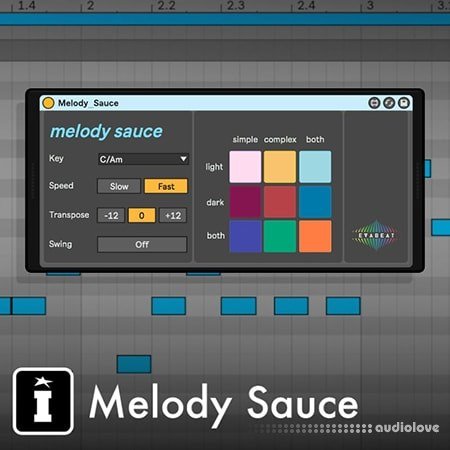Additional Libraries
Isotonik Studios MELODY SAUCE [Max for Live]

DISCOVER | 26 June 2018 | 2.63 MB
MelodySauce is a Max For Live (M4L) device that generates melodic phrases as MIDI. Designed as a music co-creation tool for anyone making music in mainstream electronic pop, dance and EDM styles, MelodySauce provides a quick and unlimited source of melodies that are created for you at the click of a button, for use as leads, synth lines, arpeggios and other instrumental hooks. With MelodySauce anyone can easily generate, audition and select credible instrumental melody and hook ideas instantly.
MelodySauce is capable of generating many millions of different permutations of melody through its complex algorithms. None of the phrases that MelodySauce generates are preprogrammed as you hear them, they are all built from scratch each time you click to generate.
Background:
MelodySauce is the culmination of 18 months’ research and development by Charlie Morgan and his EVAbeat team. Charlie Morgan has 20 years’ experience at both the creative and business ends of the music industry - originally a Royal College of Music trained classical pianist, he became an electronic writer and producer (he penned hip-house anthem “I See Girls” which reached no.12 in the UK charts some years ago) and currently runs leading music-for-commercials agency Hush Music, working with songwriters and producers to create music for the likes of Nike, Adidas and Apple in the UK and US.
Having been introduced to “generative algorithms”, Charlie became interested in the potential for algorithms to help the music creation process, and decided to develop tools that would produce credible, useable and versatile musical ideas for musicians to use that would offer a more engaging alternative to making music with loops and pre-set MIDI phrases.
Teaming up with professor of Algorithmic Musicology Louis Bigo in Paris, he came up with a unique system to analyse the musical DNA of current commercial pop and EDM songs and understand what makes them tick. Focusing initially on melody, the process involved hours of painstakingly notating songs, extracting the component parts and putting these into spreadsheets, and then analysing them mathematically to identify the common features that successful instrumental hooks share and the “melodic rules” they tend to follow.
This musical DNA was then used to build a set of algorithms, along with a unique phrase-building architecture, that would create melodies in a similar way to how a human songwriter would, at the click of a button. Charlie and the EVAbeat team are currently working on chord and beat devices.
home page
MelodySauce is capable of generating many millions of different permutations of melody through its complex algorithms. None of the phrases that MelodySauce generates are preprogrammed as you hear them, they are all built from scratch each time you click to generate.
Background:
MelodySauce is the culmination of 18 months’ research and development by Charlie Morgan and his EVAbeat team. Charlie Morgan has 20 years’ experience at both the creative and business ends of the music industry - originally a Royal College of Music trained classical pianist, he became an electronic writer and producer (he penned hip-house anthem “I See Girls” which reached no.12 in the UK charts some years ago) and currently runs leading music-for-commercials agency Hush Music, working with songwriters and producers to create music for the likes of Nike, Adidas and Apple in the UK and US.
Having been introduced to “generative algorithms”, Charlie became interested in the potential for algorithms to help the music creation process, and decided to develop tools that would produce credible, useable and versatile musical ideas for musicians to use that would offer a more engaging alternative to making music with loops and pre-set MIDI phrases.
Teaming up with professor of Algorithmic Musicology Louis Bigo in Paris, he came up with a unique system to analyse the musical DNA of current commercial pop and EDM songs and understand what makes them tick. Focusing initially on melody, the process involved hours of painstakingly notating songs, extracting the component parts and putting these into spreadsheets, and then analysing them mathematically to identify the common features that successful instrumental hooks share and the “melodic rules” they tend to follow.
This musical DNA was then used to build a set of algorithms, along with a unique phrase-building architecture, that would create melodies in a similar way to how a human songwriter would, at the click of a button. Charlie and the EVAbeat team are currently working on chord and beat devices.
home page
Only registered users can see Download Links. Please or login.


No comments yet